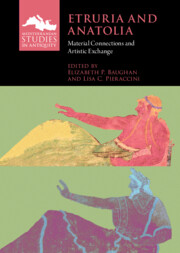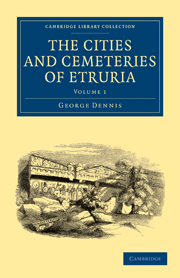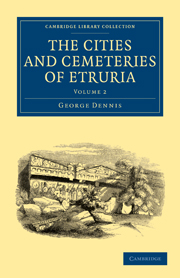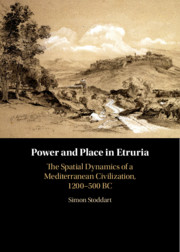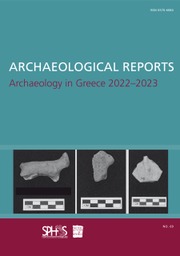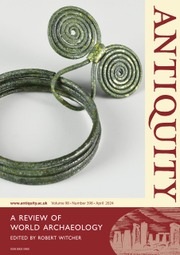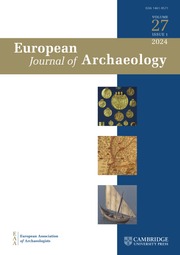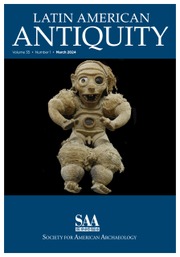Etruria and Anatolia
Striking similarities in Etruscan and Anatolian material culture reveal various forms of contact and exchange between these regions on opposite sides of the Mediterranean. This is the first comprehensive investigation of these connections, approaching both cultures as agents of artistic exchange rather than as side characters in a Greek-focused narrative. It synthesizes a wide range of material evidence from c. 800 – 300 BCE, from tomb architecture and furniture to painted vases, terracotta reliefs, and magic amulets. By identifying shared practices, common visual language, and movements of objects and artisans (from both east to west and west to east), it illuminates many varied threads of the interconnected ancient Mediterranean fabric. Rather than trying to account for the similarities with any one, overarching theory, this volume presents multiple, simultaneous modes and implications of connectivity while also recognizing the distinct local identities expressed through shared artistic and cultural traditions.
- Opens up new and innovative ways of studying the ancient Mediterranean and the micro and macro connections between peoples, cultures and artistic traditions
- Brings together detailed studies on a wide range of material evidence (from terracottas to banqueting equipment to jewelry)
- Merges traditional and innovative modes for studying the Mediterranean, allowing for a broad approach to a new field of study
Reviews & endorsements
‘… the chapters of the book draw before our eyes a vivid picture of the Mediterranean. The meticulous investigation and in-depth analysis of material evidence with a critical approach opens a new course for future research. In the end, the volume underlines the importance of further investigation and re-interpretation of material contexts for defining the cultural interaction between Etruria and Anatolia. ’ Elif Koparal, Bryn Mawr Classical Review
Product details
March 2023Hardback
9781009151023
348 pages
250 × 173 × 22 mm
0.85kg
34 b/w illus. 47 colour illus. 3 maps
Available
Table of Contents
- Introduction: Etruria, Anatolia, and Wider Mediterranean Connectivity Lisa C. Pieraccini and Elizabeth P. Baughan
- Part I. Broadening Perspectives: A Wider Mediterranean Landscape:
- 1. From East to West and Beyond Alessandro Naso
- Part II. Interpretive Frameworks:
- 2. Bridging Cultures in the Past and Present Tamar Hodos
- 3. Etruria and Anatolia: An Ancient Relationship Framed by the Modern Views of 'Orientalization' Jessica Nowlin
- 4. A Tale of Two Buccheri: East and West Theresa Huntsman
- 5. The Role of Greek Sanctuaries in Material and Artistic Interactions between Etruria and Anatolia Nassos Papalexandrou
- Part III. Technology and Mobility:
- 6. Wooden Furniture from Verucchio and Gordion Elizabeth Simpson
- 7. Refugee Terracotta Craftsmen from Anatolia in Southern Etruria and Latium, 550/540-510 BCE Nancy A. Winter
- Part IV. Shared Practices:
- 8. Etruscan Lightning and Anatolian Images: The Use and Perception of Tridents in Etruria and the East Jean MacIntosh Turfa
- 9. Luxury Consumption and Elite Lifestyles Annette Rathje
- 10. Tracing Connections Between Archaic Etruria and Anatolia in Material Culture and Funerary Ideology Fernando Gilotta
- 11. Rock Tombs and Monuments in South Etruria and Anatolia: Typology, Chronology, Ideology – Differences and Common Elements Stephan Steingräber
- Part V. Shared and Distinct Iconographies:
- 12. Wall Paintings from Gordion in their Anatolian Context Susanne Berndt
- 13. Chasing the Dog in Etruria and Anatolia: Connections, Context, and Meaning Lisa C. Pieraccini
- 14. Reconsidering Ionian and Other Eastern Influences on Etruscan Black-Figure Vase-Painting Dimitris Paleothodoros
- Part VI. Shared Forms, Distinct Functions:
- 15. Forms and Functions of Beds and Couches in Etruscan and Anatolian Tombs Elizabeth P. Baughan
- 16. Female Assembly on Archaic Etruscan and Anatolian Funerary Monuments Gretchen Meyers
- 17. Anatolian Fashion in Etruscan Clothing: The Case of the Pointed Shoes Tuna Şare Ağtürk
- 18. Male Necklaces in the East and West Alexis Q. Castor.

